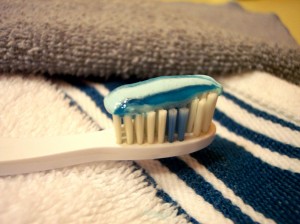by: Dr. Craig A. Maxwell
 You probably never think about it. You don’t even notice it. You get up, shower, brush your teeth, and drink a couple of glasses of water. You brew coffee, tea, cook and serve food, and all the while are completely unaware of the danger lurking in your home. That danger is fluoride and just 5 grams of it is considered a lethal dose. So why would you want to consume several milligrams daily for years?
You probably never think about it. You don’t even notice it. You get up, shower, brush your teeth, and drink a couple of glasses of water. You brew coffee, tea, cook and serve food, and all the while are completely unaware of the danger lurking in your home. That danger is fluoride and just 5 grams of it is considered a lethal dose. So why would you want to consume several milligrams daily for years?
Fluoride Has Been Recognized As A Toxic Poison For Decades
It may surprise you to know that fluoride wasn’t always a common tap water additive. Prior to 1945, before fluoride became a part of the communal water supply, it was a known and widely-publicized toxin. Articles published in the 1930s and early 1940s clearly indicated that even a small amount of fluoride is as toxic as arsenic and lead.
If fluoride is known to be a toxic poison then what was the reason for putting it into our water supply?
The prevention of dental caries (cavities).
In 1951, the use of fluoride in the U.S. water supply became an official policy implemented with the intent to reduce the number of dental caries in children. By 1960, fluoridated water reached over 50 million people. In 2006, over 60% of the United States population had fluoride in their drinking water.
There are several different types of fluoride. The main type used in toothpaste and mouthwash is SODIUM FLUORIDE. It is also used as an insecticide, pesticide, preservative in glues, manufacturing of steel and aluminum…and in the manufacture of chemical weapons.
Due to its inexpensive cost, the fluoride most commonly used in our water supply is FLUOROSILICIC ACID. According to the CDC about 95% of fluoridated tap water contains this type of fluoride. This form of fluoride is a toxic liquid by-product, acquired by scrubbing the chimney stacks of phosphate fertilizer manufacturing plants. If it were not sold as an additive to our water supply, it would have to be disposed of as a hazardous material.
Both have the same lethal potential. A single dose of 5-10 grams, depending on an individual’s size, is considered deadly.
There are several other types of fluoride which are used, but these two are the ones most likely to be ingested.
Call Poison Control If You Swallow Toothpaste or Mouthwash?
If you’ve ever looked on the back of your toothpaste tube, you’ve seen the warning: “if more than used for brushing is accidentally swallowed, get medical help or contact a poison control center right away.”
There are similar warnings on fluoridated mouthwash.
The amount of fluoride in a pea-sized amount of toothpaste (about a quarter of a milligram) is about the same amount you will find in an 8 ounce glass of tap water. Most doctors recommend drinking at least 8 glasses of water a day, without giving much thought as to the source of that water. If it is fluoridated tap water, the amount of fluoride rapidly adds up. And the amount added to the water supply varies quite widely depending on where you live.
Fluoride accumulates in many body tissues over time. It is the chronic, daily exposure to fluoride which poses the most risk. It is a cumulative toxin in small amounts.
If you are supposed to call a poison control center when you ingest just a minute amount of fluoridated dental product, how could fluoridated water be safe to drink?
It’s not safe at all. Recent studies have emerged to show that fluoride is one of the most deadly forms of poison on the planet.
Fluoride Dangers You Need to be Aware Of
Fluoride is the only chemical added to water for the sole purpose of medicating the population. Do you remember anyone asking you for permission to medicate your water supply?
Here are some of the disturbing side effects associated with fluoride:
- Neurological Damage
One of the worst problems with fluoride is its potential to cause severe neurological damage. According to a study published in the Journal of Medical and Allied Science, rats treated with sodium fluoride showed signs of disturbing neurodegenerative changes. When ingested, sodium fluoride crosses the blood-brain barrier and alters the function of neural tissue at the cellular level.
Neurological damage can show itself in multiple ways. Lowered IQ, developmental delays in children including autism and ADHD, and non-specific sensory processing disorders are some of the more common brain disorders believed to be caused by fluoride.
Other signs of neurological damage include behavioral disorders, emotional outbursts, insomnia, impulse control, impaired motor skills, learning disabilities, muscle twitching, movement disorders, and chronic headaches.
- Autoimmune Disease

Incidents of autoimmune disease are on the rise due to poor diet, stress, and environmental toxins. One of the most prevalent toxins in the environment is the fluoridated water you may be drinking every day. Studies have indicated that regular exposure to fluoride has a “complex and relevant effect” on the T-Regulatory cells of humans.
- Thyroid Dysfunction
Next to neurological damage, thyroid dysfunction is one of the more prevalent fluoride dangers. The Department of Health and Human Services (DHHS) estimates that total daily fluoride exposure ranges from 1.6 to 6.6 milligrams per day. It has been proven just 2.3 ppm of fluoride can have a profoundly negative effect on thyroid function.
The middle of the 20th century had European physicians prescribing fluoride as a treatment for hyperactive thyroid. It is no small wonder that so much of the United States population suffers from autoimmune thyroiditis (Hashimoto’s) and hypothyroidism. This unnecessary “medication” has rendered many depressed, lethargic, overweight, confused, and compliant.
Is this simply a coincidence?
- Infertility
One of the more disturbing fluoride dangers investigated is its ability to cause infertility in both men and women. According to statistics, the Total Fertility Rate (TFR) for the years 1950-2015, has dwindled by more than half. In 1950, the TFR was 4.95 children. By 2015, the projected TFR is 2.36.
Research has shown that even small amounts of fluoride result in abnormalities in male fertility, with semen deficiency and low testosterone levels. In women, fluoride seems to affect the arteries, causing ectopic calcification and repeated miscarriages.
Studies Show Fluoride Increases Risk of Dental Cavities
One of the most ironic things about fluoridated water is that it does nothing to prevent dental cavities. Time and time again, multiple studies have revealed that when fluoride is removed from the water supply, cavity rates begin to decline!
California and Hawaii, two of the least fluoridated states, have shown the least amount of tooth decay and loss. In contrast, Kentucky and West Virginia have the most toothless residents with 81% of their water supply being fluoridated.
How to Avoid Fluoride Contamination
Drinking bottled spring water is one way to reduce your fluoride consumption. Make sure it is pure spring water, and not just filtered water from a municipal water supply, as many bottled water products are. Spring water can have low levels of fluoride, but fluoridated tap water contains 14-24 times more.
If you drink any products from plastic bottles, make sure the container DOES NOT have the number “7” on the bottom. Plastics with this number are likely to have bisphenol-A (BPA), or bisphenol-S (BPS), both neuroendocrine disruptors. I’ll be addressing BPA and BPS in future articles.
If possible, invest in a reverse osmosis filtration system for your home. Reverse osmosis filters remove not only dangerous fluoride but bacteria, viruses, chlorine, and radioactive contaminants as well. If a reverse osmosis filter is out of your budget, you can also remove fluoride with an activated alumina filter.
When choosing toothpaste, make sure your brand is organic and fluoride free. You can also make your own toothpaste at home. There are dozens of natural toothpaste recipes on the Internet. Baking soda, clove oil, coconut oil, mint, and peroxide are popular homemade toothpaste ingredients.
Remember, a big part of reducing tooth decay and gum disease is the mechanical action of properly brushing and flossing at least two times a day. A new toothbrush about every three months is also highly recommended. And, of course, visit your dentist twice a year.
Also, don’t feed those oral bacteria (streptococcus mutans) the fuel they need to produce acid and erode your tooth enamel…sugar (sucrose and high fructose corn syrup). Eventually these bacteria penetrate the dentine, at which point tooth decay sets in.
In addition to water, mouthwash and toothpaste, fluoride can also be found in non-stick pans. If you’re using non-stick cookware, you might want to consider trading them in for cast iron or stainless steel.
With all the dangerous health effects of fluoride, it’s important you avoid it whenever possible. Once you remove as many sources of fluoride as possible, your body will do what it was designed to do….detoxify itself.









